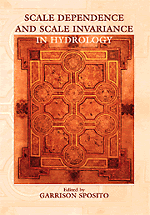Book contents
- Frontmatter
- Contents
- List of Contributors
- Preface
- 1 Scale Analyses for Land-Surface Hydrology
- 2 Hillslopes, Channels, and Landscape Scale
- 3 Scaling in River Networks
- 4 Spatial Variability and Scale Invariance in Hydrologic Regionalization
- 5 An Emerging Technology for Scaling Field Soil-Water Behavior
- 6 Scaling Invariance and the Richards Equation
- 7 Scaling of the Richards Equation and Its Application to Watershed Modeling
- 8 Scale Issues of Heterogeneity in Vadose-Zone Hydrology
- 9 Stochastic Modeling of Scale-dependent Macrodispersion in the Vadose Zone
- 10 Dilution of Nonreactive Solutes in Heterogeneous Porous Media
- 11 Analysis of Scale Effects in Large-Scale Solute-Transport Models
- 12 Scale Effects in Fluid Flow through Fractured Geologic Media
- 13 Correlation, Flow, and Transport in Multiscale Permeability Fields
- 14 Conditional Simulation of Geologic Media with Evolving Scales of Heterogeneity
- Index
6 - Scaling Invariance and the Richards Equation
Published online by Cambridge University Press: 18 January 2010
- Frontmatter
- Contents
- List of Contributors
- Preface
- 1 Scale Analyses for Land-Surface Hydrology
- 2 Hillslopes, Channels, and Landscape Scale
- 3 Scaling in River Networks
- 4 Spatial Variability and Scale Invariance in Hydrologic Regionalization
- 5 An Emerging Technology for Scaling Field Soil-Water Behavior
- 6 Scaling Invariance and the Richards Equation
- 7 Scaling of the Richards Equation and Its Application to Watershed Modeling
- 8 Scale Issues of Heterogeneity in Vadose-Zone Hydrology
- 9 Stochastic Modeling of Scale-dependent Macrodispersion in the Vadose Zone
- 10 Dilution of Nonreactive Solutes in Heterogeneous Porous Media
- 11 Analysis of Scale Effects in Large-Scale Solute-Transport Models
- 12 Scale Effects in Fluid Flow through Fractured Geologic Media
- 13 Correlation, Flow, and Transport in Multiscale Permeability Fields
- 14 Conditional Simulation of Geologic Media with Evolving Scales of Heterogeneity
- Index
Summary
Introduction
A culminating step in the early development of soil-water physics as a predictive science was taken 65 years ago with the appearance of the Richards equation (Richards, 1931). This parabolic partial differential equation describes the temporal and spatial dependences of the volumetric water content during infiltration in a nondeformable, unsaturated porous medium at fixed temperature and applied pressure. The solutions of the Richards equation, whether analytical or numerical, play a key role in the mathematical theory of hydrologic processes near the land surface (Hillel, 1980; Kuhnel et al, 1990; Wang and Dooge, 1994; Sposito, 1995).
The physical basis of the Richards equation lies in fundamental postulates about continuum descriptions of multiphase systems and the mechanisms of transport for water in an unsaturated porous medium (Sposito, 1987). The mechanistic postulates invoke empirical “transport coefficients” (e.g., hydraulic conductivity or soil-water diffusivity) whose functional dependence on volumetric water content is presumed known through laboratory or field measurement. The exact nature of the functional dependence differs among porous media of various compositions and textures and therefore among locations in a heterogeneous field soil or sedimentary deposit whose physical properties vary spatially. This medium-specific (or site-specific) character of the transport coefficients adds great complexity to any use of the Richards equation in modeling vadose-zone hydrology (Warrick and Nielsen, 1980).
One option for reducing the complexity is through an application of “similitude analysis” to the Richards equation (Miller, 1980).
- Type
- Chapter
- Information
- Scale Dependence and Scale Invariance in Hydrology , pp. 167 - 189Publisher: Cambridge University PressPrint publication year: 1998
- 7
- Cited by



